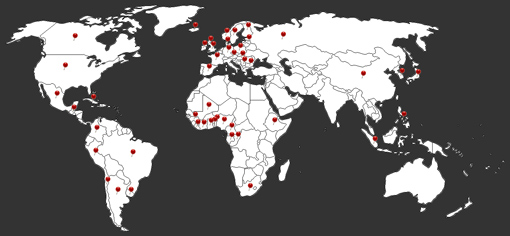permanent collection
As curators and conservators, we are in the business of preserving not only the works of art, but also their legends. We have a responsibility not only to fix the works, but also to capture the personalities that created them. —Paul Schimmel
The Museum's collection began in the usual way for those institutions not founded upon a significant collection. That is, in the late 1980s and early 1990s the fledgling Museum began to collect individual paintings, works on paper, photographs, and sculpture, often drawn from its own exhibitions organized in-house. Money was hard to come by, but there was so much promise, Director Laurel Reuter remembers.
Exhibitions curated by the Museum brought important work into the collection, sometimes purchased from the show, sometimes gifts from the artists. For example, “The Disappeared” brought in art by Nicolas Guagnini, Ana Tiscornia, Luis Gonzáles, Sara Maneiro, Juan Manuel Echavarría, and Antonio Fransconia. The Museum also commissions works that become exhibitions as well as valuable additions to the collection.
While originally anchored in contemporary Western art from 1989 to the present, the Museum’s collections have begun to expand, to move back in time to the early people of the Northern Plains both then and now. To much of Africa as its art evolved and was used during the twentieth century. To far more ancient Egypt. To the art of the Southern Hemisphere where European and indigenous peoples folded together to become Latin Americans of various tribes, states, and art forms. Slowly, as money accumulates and the Museum’s imprint expands, the Museum’s collections are reflecting a greater world.
In 2013, the Museum will open its first period room, Barton’s Place, a Twenty-first Century Artist’s Studio. In addition to Barton’s own art work, it will house his collections of African, Egyptian, and Amazonian art, plus taxidermy, mystical and taboo objects, and twentieth-century and religious art. Such collections as these don’t exist in North Dakota. And, if they can be placed in proximity to an American Indian gallery, the amalgamation will produce a power and complexity not obtainable alone.
Over the years, the Museum gradually acquired works by contemporary American Indian artists. In 2011, however, the pace and focus shifted. It was decided that the Museum’s resources would be concentrated upon elevating American Indian artists to the status they should hold in North Dakota and beyond. As part of a much larger collaboration with Spirit Lake’s Cankdeska Cikana Community College, the Museum would fund commissions and purchases of art by and from American Indian artists to keep our promise that we will be supporting them in new ways, and to begin the collection of Native art that is essential to the success of the North Dakota Museum of Art.
Artists in Permanent Collection
African Ceramics
Archambeau, Robert
Belleveau, Albert
Birgisson, Birgir Snaebjorn
Bosworth, Barbara
Dow, Jim
Dukes, Caroline
Dunham, Carroll
Echavarria, Juan Manuel
Effendi, Rena
Evans, Terry
Eyjolfsson, Helgi Hjaltalin
Frankenthaler, Helen
Fridjonsson, Helgi
Friese, Nancy
Funakoshi, Katsura
Geist, Del
Guagnini, Nicolas
Hanson, Glen
Hitchcock, John
Houser, Allan
Jensen, Bill
Johnson, Samuel
Jonsdoittir, Kristin
Klett, Mark
Klipper, Stuart
La Noue, Terence
Lee, Susie J.
Letinsky, Laura
Lunde, Emily
MacDonald, Elizabeth
MacKenzie, Warren
Mojsilov, Zoran
Motherwell, Robert
Murray, Elizabeth
Neel, Victoria
Newman, John
Nonas, Richard
Nusz, Ruben
Oltvedt, Carl
Peluce, Robert
Polidori, Robert
RES
Rey, Dyan
Rosenquist, James
Rothenberg, Susan
Santiago, Paula
Schnabel, Julian
Sillman, Amy
Sime, Elias
Snyder, Jon
Sordek-Hart, Guillermo
Sorman, Steven
Soth, Alec
Strand, Todd
Sultan, Donald
Szeitz, Richard
The Oakes Twins
Traverso, Fernando
Wall-Romana, Margaret
Webb, Alex
Webb, Rebecca Norris
Wilson, Francis
Winard, Rosalie
Winters, Terry

